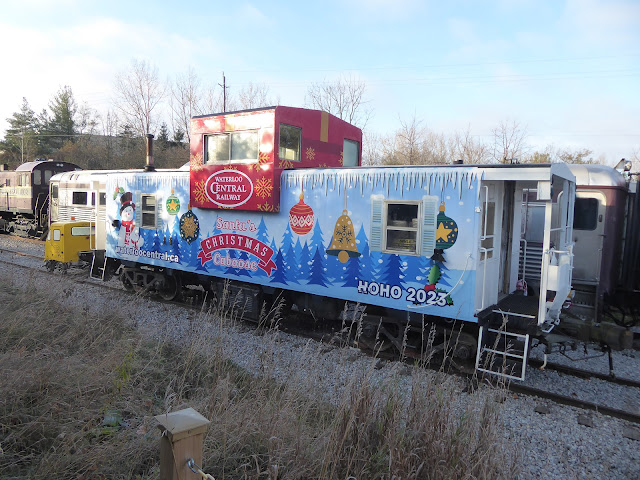Back in November, I was in Kitchener-Waterloo for a conference, where I was giving a mental health presentation. I made sure to carve out some time trackside, as KW has some unique rail photo opportunities. You can read about my time trackside in Kitchener here. My first stop was St. Jacobs, a small community north of the City of Waterloo. St. Jacobs is known for its area old order Mennonite population (think horse and buggies) as well as its tourist industry, which is very much a mainstay of the local economy.
The Waterloo Central Railway has a yard located in the town, which serves as its maintenance facility and starting point for some tourist excursions. At one point, the WCR operated from the former Waterloo train station, but the rails south of St. Jacobs are now all occupied by the Ion light rail system. CN still operates local freight operations during off hours, which you can read about in this Traingeek.ca blog entry. But the area is off limits to the WCR.
You might recall I've been to this yard a few times, which you can read about here and here.
This time around, I arrived in the early morning, as this was the only time I had to take photos. I was quite happy to get a few shots of the WCR's former Essex Terminal Railway caboose, clad in a wrap that would be useful for its Christmas Train. The railway added some nice touches, like the HOHO 2023 operating mark. Also, as a communications professional, I always like it when a business includes its web address in a visible spot. I remember a marketing professional telling me she couldn't understand why a company would ever hesitate to share its website at every opportunity.
You can even see the WCR speeder to the left of the caboose as well as a Budd-build RDC unit behind the caboose. I got all these shots from a small park next to the railyard, which offers you some great vantage points to get photographs. It's like visiting a rail museum for free. There is even a street just north of this park that ends at the tracks, where you can get some shots from a different vantage point, but stay on public property (the street). There are signs here that clearly show you where you can and cannot go, as there are homes and a small trackside business here.
There were some other interesting things to see in the yard, as the railway was clearly getting ready to assemble a Christmas train. If you look closely at this old passenger coach, you can see that the crews had already strung up lights around the windows and across the top and bottom of the car. The WCR is clearly influenced by a love of vintage Canadian Pacific colours, as many of its cars and locomotives sport CP's maroon (Tuscan red, technically) and grey scheme, which was officially ditched in 1968 for the action red multimark livery.
This coach, however, is actually a former CN coach, built in 1954 by Canadian Car and Foundry. It served well into the Via Rail era, where it took on the blue and yellow scheme, before finding its way into the BC Rail fleet, where it became known as Sunset Beach, and finally the Orangeville-Brampton Railway. Coach 1978 has been with WCR since 2018.
In previous years, WCR kept some of its coaches in the blue and yellow Via Rail scheme. I was lucky to get a shot of one of the last coaches to sport this scheme. I was happy I did, as I have great memories of these old blue and yellow cars as a kid.
Here's a sun-drenched shot of two S13s 1001 (left) and 1002 in the yard. Each unit was built by the Montreal Locomotive Works in 1959. While each bears the colours of the pre-action mark CP, these units were actually Pacific Great Eastern (later BC Rail) units upon delivery. After serving out west, they spent time on the Greater Winnipeg Water District Railway as 501 and 502, before moving further east and operating for the Ontario Southland Railway with the same numbers. They have been with the WCR since 2018. It's incredible to think of how much revenue service these old units have seen.
A little deeper in the yard, another MLW unit, this one ex-CP S3 6593, was sitting with a mixed consist, including 1930s vintage ex-CN baggage car 8751, a tank car and a former Toronto, Hamilton & Buffalo boxcar. Unlike the other units, this one was originally a CP unit, built in 1957. For Ottawa railfans, they might be interested to know that CP sold it to the National Research Council, where it served as the NRC switcher at its ground transportation research centre along the old CP Prescott Sub, near the Ottawa International Airport. It was sold to the WCR in 2012. Here is a cool shot from its move from Walkley Yard back in 2012. This unit began its work in these maroon and grey colours before being switched to action red, so this is likely a fitting scheme for this old unit.
The railway explains on its website that its small collection of rolling stock is for the purposes of television and movie work, where productions might need to include a freight train in a scene. Since the WCR also has a steam engine on its roster, I would imagine have a tank car might come in handy as well for the purposes of feeding the engine water.
All in all, it was a fun visit to this area. I will share a few more images from this morning in another post, since there was quite a bit to see in a brief time.





2 comments:
Nice views of the Waterloo Central!
I hope to actually see one of their trains operate...
Yes, as much as I love taking static shots!
Post a Comment